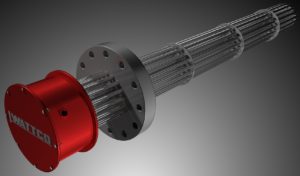Heating Alternatives: Waste Water Immersion Heaters
Last updated on March 5th, 2024 at 04:08 pm
An immersion heater is a device that heats fluids that are present in a container. Immersion heaters directly heat fluids in a tank or container to achieve a desired temperature quickly and effectively. There are many types of wastewater immersion heaters available in the market today. Before we identify the different kinds, let’s take a look at the applications these heaters can be used for. As far as wastewater management is concerned, the primary role of immersion heaters is to protect liquids from freezing. Frozen wastewater can halt the processes from happening and potentially lead to unnecessary overflows. Here is a list of the different types of immersion heaters that can be used to treat wastewater:
 Flanged Immersion Heaters
Flanged Immersion Heaters
The structure of the flanged immersion heaters is substantially complex. These immersion heaters are made of tubular elements that are bent, welded/brazed and coupled with electrical connections to wiring boxes. Flanged immersion heaters are installed by bolting the unit to a welded flange that is attached to either the tank or the containers nozzle. Flanged immersion heaters have a variety of size options, sheath materials, voltage and kilowatt ratings. Flanged immersion heaters are one of the most popular options used for heating liquids in a variety of processes. They are designed to function in low or high pressure vessels and tanks making these easy to maintain and install. Flanged heaters use the direct heat immersion method, making the heating process faster and more efficient way. These heaters utilize the standard pipe flanging ranges that start from 3” to approximately 14” in diameter. The pipes are used to help the heater unit negotiate with the high tank pressures that a liquid may exhibit.
Screw Plug Heaters
Screw plug immersion heaters are also known as threaded immersion heaters. The structure of a screw plug immersion heater differs from flanged heaters because the tubular elements are brazed/welded into a screw plug. As the name suggests, the installation of screw plug heaters is done by screwing the unit into a threaded opening in a vessel, container, or a tank. Like flanged heaters, there’s a wide variation in terms of different sizes, sheath materials, voltage and kilowatt ratings. Screw plug immersion heaters are traditionally used in food and chemical industries to quickly heat liquids such as water or glycol that can help in a variety of processes in wastewater management i.e. to prevent it from freezing so that it can be used with clean water, oils, chemicals, etc.
